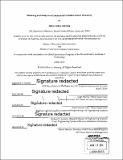Modeling and analysis of commercial finished goods inventory
Author(s)
Schrang, Oliver Stiles
DownloadFull printable version (7.372Mb)
Other Contributors
Leaders for Global Operations Program.
Advisor
Leigh Hafrey and David Simchi-Levi.
Terms of use
Metadata
Show full item recordAbstract
As the commoditization of the PC market erodes product margins, increasing emphasis is placed on cost optimization within the supply chain. One critical component of this is the financial impact of inventory policies and the transportation choices affecting these policies. Overseas manufacturing and ocean transportation are the most cost-effective solutions, but this requires building products to a forecast. The uncertainty induced by forecasts affects the inventory volumes necessary to achieve specified service levels. Inventory volume and its associated holding cost can be reduced through air transport, but this must be balanced against the increased expense of this particular shipping option. This thesis seeks to develop a framework informing inventory levels, transportation policies, and replenishment decisions. Holding inventory to a target level that does not vary across product type or replenishment method has the advantages of ease of management and low inventory variability within merge centers, but is sub-optimal from a customer satisfaction and cost perspective. The model presented introduces a flexible approach that considers variations in product characteristics to determine optimal inventory and transportation strategies. Differences between generalized target inventory levels and the levels achievable through a non-uniform approach are demonstrated. The implications of these inventory levels on required forecast accuracy levels are also considered. From these differences are extrapolated cost savings under current commercial finished goods volumes for the North American region as well as target volumes for the same. Current and target ocean volumes are discussed, with an analysis of their effect on inventory levels and costs.
Description
Thesis: S.M., Massachusetts Institute of Technology, Engineering Systems Division, 2014. In conjunction with the Leaders for Global Operations Program at MIT. Thesis: M.B.A., Massachusetts Institute of Technology, Sloan School of Management, 2014. In conjunction with the Leaders for Global Operations Program at MIT. Cataloged from PDF version of thesis. Includes bibliographical references (pages 55-56).
Date issued
2014Department
Leaders for Global Operations Program at MIT; Massachusetts Institute of Technology. Engineering Systems Division; Sloan School of ManagementPublisher
Massachusetts Institute of Technology
Keywords
Engineering Systems Division., Sloan School of Management., Leaders for Global Operations Program.